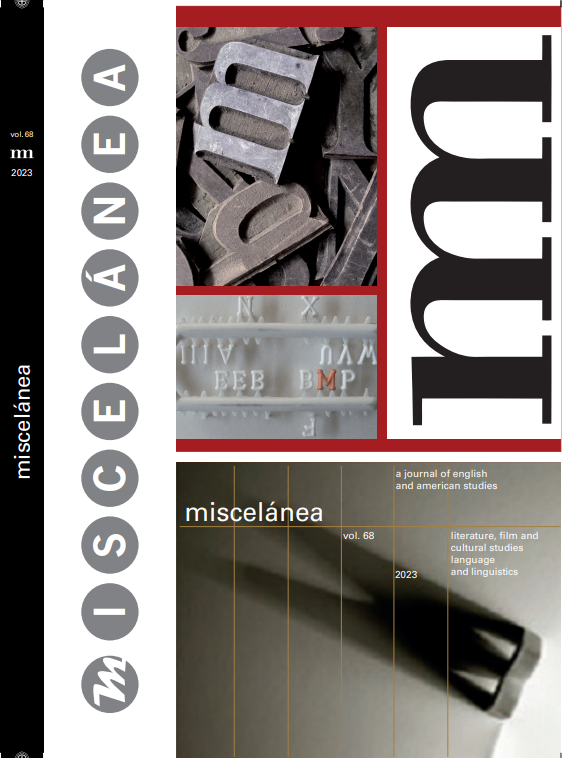Jurassic World: Fallen Kingdom como ficción gótica del siglo XXI:
Una revisión antiespecista de la monstruosidad
DOI:
https://doi.org/10.26754/ojs_misc/mj.20237347Palabras clave:
Jurassic World, Jurassic Park, Gothic film, monster film, antispeciesismResumen
Este artículo propone la película de Juan Antonio Bayona Jurassic World: Fallen Kingdom (2018) como un film gótico que altera las convenciones arquetípicas del cine de monstruos, especialmente en lo referido a la consideración antiespecista de estas criaturas —en este caso, los dinosaurios creados mediante ingeniería genética que protagonizan las sagas de Jurassic Park y Jurassic World. A través del análisis de su cinematografía, la construcción de los personajes y escenarios, y el desarrollo de la trama a través de los Gothic Studies, argumentaré que esta película no se encuadra dentro del género solamente por su aspecto formal, sino también en el sentido de que rompe con las convenciones antropocéntricas contemporáneas
alrededor de la normatividad, unidad y los límites entre especies. Asimismo, confirma la tendencia de las narrativas fílmicas que tienen en consideración la perspectiva de los monstruos con el fin de impugnar la idea del excepcionalismo humano.
Descargas
Citas
Adams , Carol. (1990) 2015. The Sexual Politics of Meat - 25th Anniversary Edition: A Feminist-Vegetarian Critical Theory. New York: Bloomsbury Publishing.
Aldana Reyes, Xavier. 2020. Gothic Cinema. London and New York: Routledge.
Bayona, Juan Antonio. 2018. Jurassic World: Fallen Kingdom. Universal Pictures.
Braidotti , Rosi. 2013. The Posthuman. New Jersey: John Wiley and Sons.
Bruhm, Steven. 2002. “The Contemporary Gothic: Why we Need it”. In Hogle, Jerrold E. (ed.): 259-276.
Cohen, Jeffrey Jerome. 1996. Monster Theory: Reading Culture. Minnesota: University of Minnesota Press.
Curtis , Barry. 2008. Dark Places: The Haunted House in Film. London: Reaktion Books.
Deckard, Sharae. 2019. “Ecogothic”. In Aldana Reyes, Xavier and Maisha Weister (eds.) Twenty-First-Century Gothic: An Edinburgh Companion. Edinburgh: Edinburgh U.P.
Fischer, Bob. 2021. Animal Ethics: A Contemporary Introduction. New York: Routledge.
Fisher, Kenn. 2014. “Decline of the Meatosaurus”. In Michaud, Nicolas and Jessica Watkins (eds.) Jurassic Park and Philosophy: The Truth Is Terrifying. Chicago: Open Court.
Ford Coppola, Francis. 1992. Bram Stoker’s Dracula. Columbia Pictures.
Grazier, Kevin R. 2008. The Science of Michael Crichton: An Unauthorized Exploration into the
Real Science behind the Fictional Worlds of Michael Crichton. Dallas: BenBella Books.
Gregersdotter , Katarina, Nicklas Hållén and Johan Höglund. 2015. “Introduction”. In Gregersdotter, Katarina, Nicklas Hållén and Johan Höglund (eds.) Animal Horror Cinema: Genre, History and Criticism. London: Palgrave Macmillan: 1-18.
Gruen, Lori. 2012. Ethics and Animals: An Introduction. Cambridge: Cambridge U.P.
Halberstam , Jack. 1995. Skin Shows: Gothic Horror and the Technology of Monsters. London: Duke U.P.
Hand, Richard J. and Jay McRoy. 2020. “Introduction”. In Hand, Richard J. and Jay McRoy (eds.) Gothic Film. An Edinburgh Companion. Edinburgh: Edinburgh U.P.: 1-7.
Hitchcock, Alfred. 1940. Rebecca. Selznick International Pictures.
Hogle, Jerrold E. (ed.) 2002. The Cambridge Companion to Gothic Fiction. Cambridge: Cambridge U.P.
Hogle , Jerrold E. 2002. “Introduction: the Gothic in Western Culture”. In Hogle, Jerrold E. (ed.):1-20.
Kavka, Misha. 2002. “The Gothic on Screen”. In Hogle, Jerrold E. (ed.): 209-228.
Khapae va, Dina. 2019. “Eaten in Jurassic World: Antihumanism in Popular Culture”. In Khapaeva,
Dina (ed.) Man-Eating Monsters: Anthropocentrism and Popular Culture. Bingley: Emerald Publishing: 15-34.
Milbank, Alison. 1998. “Female Gothic”. In Mulvey-Roberts, Marie (ed.) The Handbook to Gothic Literature. New York: New York U.P.: 53-57.
Moers, Ellen. 1976. Literary Women. New York: Anchor Books.
Murnau , Friedrich Wilhelm. 1922. Nosferatu, eine Symphonie des Grauens. Kino Lorber.
Parry, Geraint. 2015. “Jurassic World: Just How Impossible Is it?” The Biochemist 37 (6): 18-21. <https://doi.org/10.1042/BIO03706018>.
Shildrick, Margrit. 2002. Embodying the Monster. Encounters with the Vulnerable Self. London: Sage.
Smith, Andrew and William Hughes. 2013. EcoGothic. Manchester and New York: Manchester U.P.
Suvin, Darko. 1979. Metamorphoses of Science Fiction: On the Poetics and History of a Literary Genre. New Haven and London: Yale U.P.
Vidler, Anthony. 1994. The Architectural Uncanny: Essays in the Modern Unhomely. Cambridge, Massachusetts and London: MIT Press.
Wallace , Diana and Andrew Smith. 2009. The Female Gothic: New Directions. New York: Springer.
Wise, Robert. 1963. The Haunting. Metro-Goldwyn-Mayer.
Wolfe, Cary. 2009. What Is Posthumanism? Minneapolis: University of Minnesota Press.
Wright, Laura. 2015. The Vegan Studies Project: Food, Animals, and Gender in the Age of Terror. Athens, Georgia and London: University of Georgia Press.
Descargas
Publicado
Cómo citar
Número
Sección
Licencia
Derechos de autor 2023 Xiana Vázquez Bouzó

Esta obra está bajo una licencia internacional Creative Commons Atribución-NoComercial 4.0.
Aceptado 2023-10-04
Publicado 2023-12-19


